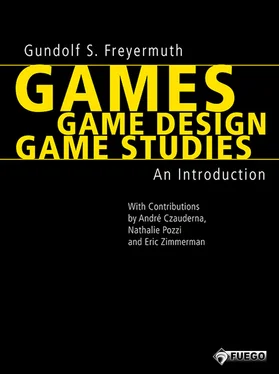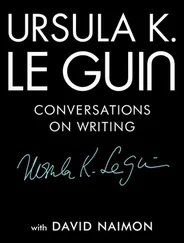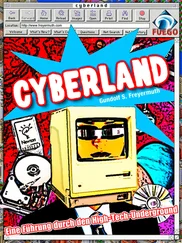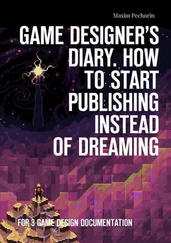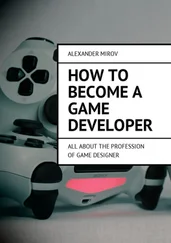So it is true for the majority of digital games then, as Frans Mäyrä writes, that they are “in fact remediated, or ‘disguised’ versions of non-digital ones,” 21i.e., they remediate “activities or forms of representation that have originally appeared elsewhere.” 22
PLAYFUL USE OF DIGITAL TECHNOLOGY
A rare exception from the 1960s is SPACEWAR! Instead of looking to board games or sports, SPACEWAR! designer and programmer Steve Russell was inspired by science fiction novels and movies, but especially by Edward Elmer Smith’s “Lensman” series. 23In its rudimentarily narrative orientation, SPACEWAR! thereby pointed to the hyper-epic future of the new medium, and in its graphical form it indicated a hyperrealistic future: The advanced vector-graphic monitor showed, on top of the mostly astronomically accurate night sky, two spaceships that shot torpedoes at each other and evaded each other per hyperspace jump, while taking care not to fall into deadly gravitational fields.
The game, programmed by MIT students in the sixties, spread throughout the computer labs of American universities. Computer manufacturer DEC finally included it with all $120,000 PDP-1 systems because it served to effectively demonstrate the machine’s capabilities. The future founder of Atari, Nolan Bushnell, was among the thousands of Computer Science students who were deeply influenced by SPACEWAR! In 1971, he produced COMPUTER SPACE, an arcade adaptation of SPACEWAR! and thereby initiated the transition from mechanical-electrical to digital arcade games. A further adaptation for the digital home console Atari 2600 followed in 1978 under the title SPACE WAR.
PROCEDURALITY
In the early stages of the digitalization of games, a categorical turn toward procedurality manifested itself among the virtual adaptations of board and sports games as well as simulations and other ludic creations. At the end of the 1990s, Janet H. Murray recognized procedurality as a special quality of digital narrations, which she called “cyberdrama”: “The most important element the new medium adds to our repertoire of representational powers is its procedural nature, its ability to capture experience as systems of interrelated actions.” 24Ian Bogost later introduced procedurality into Game Studies as a term describing the medial affordance for the construction of dynamic models of real-world processes: “This ability to execute a series of rules fundamentally separates computers from other media.” 25Digital games use procedurality as their “core representational model.” 26They possess then, in contradistinction to both their analog predecessors and to linear audiovisual media, a new systemic modus of representation. Because of their medial characteristics they do not simply—as is the case with literature—describe systems, or merely—as is the case with visual arts and photography, theater, film, television—represent them visually or audiovisually. Rather digital games are able to simulate how systems function and thereby they enable players to experience these systems.
Until now, the procedurality of digital games has primarily resulted from individual design and human programming. It is, so to speak, produced by heads and hands, through knowledge-work and manual labor. Only recently have attempts been made to automate these processes, i.e., to procedurally generate procedurality; for example, in the production of central elements of game worlds like the galaxies of ELITE: DANGEROUS (2014), the planets of NO MAN’S SKY (2015, in development) and STAR CITIZEN (2015, in development) or even procedurally-generated quests like in the MMO EVERQUEST NEXT (2015, in development). 27
Such automation seems to be the telos of procedural narration. From simple rules, algorithms allow for the creation and manipulation of complex game situations in real time; a feat which could never be matched by human calculation and deduction. This could lead to emergent and truly surprising storylines, both unplanned and unanticipated in nature; an imminent narratological phenomenon far beyond what is possible in analog games, and of course linear audiovisions as well. 28
When one looks at early digital games—even the truly innovative SPACEWAR!—it seems hardly imaginable that, only a few decades later, their descendants would challenge cinema and television. This competition arose from two more qualitative developmental advancements that would radically change the digital medium once again.
1Egenfeldt-Nielsen et al.: Understanding Video Games , loc. 213.—My portrayal of the history of digital games is based on Donovan, Tristan: Replay ; Egenfeldt-Nielsen et al.: Understanding Video Games ; Kent, Steve L.: The Ultimate History of Video Games: From Pong to Pokémon and Beyond: The Story Behind the Craze That Touched Our Lives and Changed the World , Roseville, Calif.: Prima Pub. 2001; Mäyrä: An Introduction to Game Studies ; Wolf, Mark J. P.: The Medium of the Video Game , Austin: University of Texas Press 2002.
2See above, p. here.
3Juul: Half-Real , loc. 575.
4Ibid., loc. 580.
5Turing, Alan: “On Computable Numbers, with an Application to the Entscheidungsproblem,” Proceedings of the London Mathematical Society , ser. 2. vol. 42 (1936-7). http://www.abelard.org/turpap2/tp2-ie.asp
6Neumann, John von: “First Draft of a Report on the EDVAC,” (1945). http://www.virtualtravelog.net/wp/wp-content/media/2003-08-TheFirstDraft.pdf
7The term ‘software’ itself was coined 13 years later. See Leonhardt, David: “John Tukey, 85, Statistician; Coined the Word ‘Software’,” The New York Times , July 28, 2000; http://www.nytimes.com/2000/07/28/us/john-tukey-85-statistician-coined-the-word-software.html
8Shannon, Claude Elwood: “A Mathematical Theory of Communication,” The Bell System Technical Journal Vol. 27, July / October (1948), republished with corrections from The Bell System Technical Journal ; http://cm.bell-labs.com/cm/ms/what/shannonday/paper.html.—Even the basic technical invention of digitalization, Bill Shockley’s transistor, dates to 1948. With it began the steady process of performance optimization, miniaturization, and reduction in price, which transformed the computer from large-scale technology—still part of Industrialization—to a private machine for the first time. In this way, the computer developed into a means for individual empowerment.
9Licklider, J. C. R.: “Man-Computer Symbiosis,” IRE Transactions on Human Factors in Electronics HFE-1 (1960); http://www.memex.org/licklider.pdf
10See Friedewald, Michael: Der Computer als Werkzeug und Medium: Die geistigen und technischen Wurzeln des Personal Computers , Berlin: GNT-Verlag 1999, p. 16. Also Carlson, David E., “David Carlson's Online Timeline [Carlson's New Media Timeline] (1960 to present). Interactive Media Lab., University of Florida,” (since 1998).
11See Stone, Allucquere Rosanne.: The War of Desire and Technology at the Close of the Mechanical Age , Cambridge, Mass.: MIT Press 1995, p. 13f.
12Cited from Donovan: Replay , loc. 112.
13The 1951 presented Nimrod-Computer defeated headline-grabbing German Secretary of Commerce, and later Federal Chancellor, Ludwig Erhard.
14Cited from Donovan: Replay , loc. 136.
15See Campbell-Kelly et al.: Computer , p. 157ff.
16See Rolfe, J. M./Staples, K. J.: Flight Simulation , Cambridge [Cambridgeshire]; New York: Cambridge University Press 1986, p. 234.: “The Mercury, Gemini and Apollo missions were supported by a wide variety of training simulators.”
17See Campbell-Kelly/Aspray: Computer , p. 249.
18 Guinness Buch der Rekorde , Hamburg: Guinness Verlag GmbH 2001, p. 113. Sales figures from the year 1999 were used.
Читать дальше
